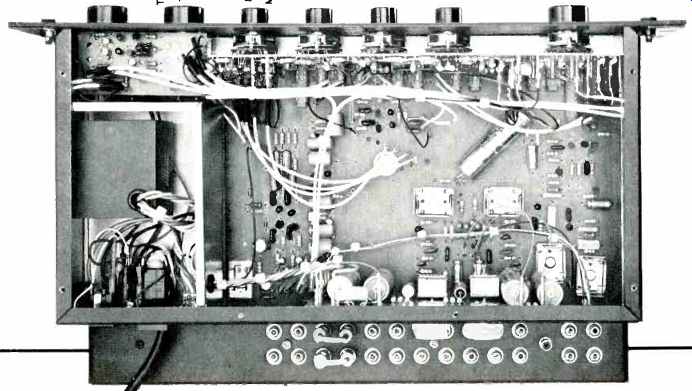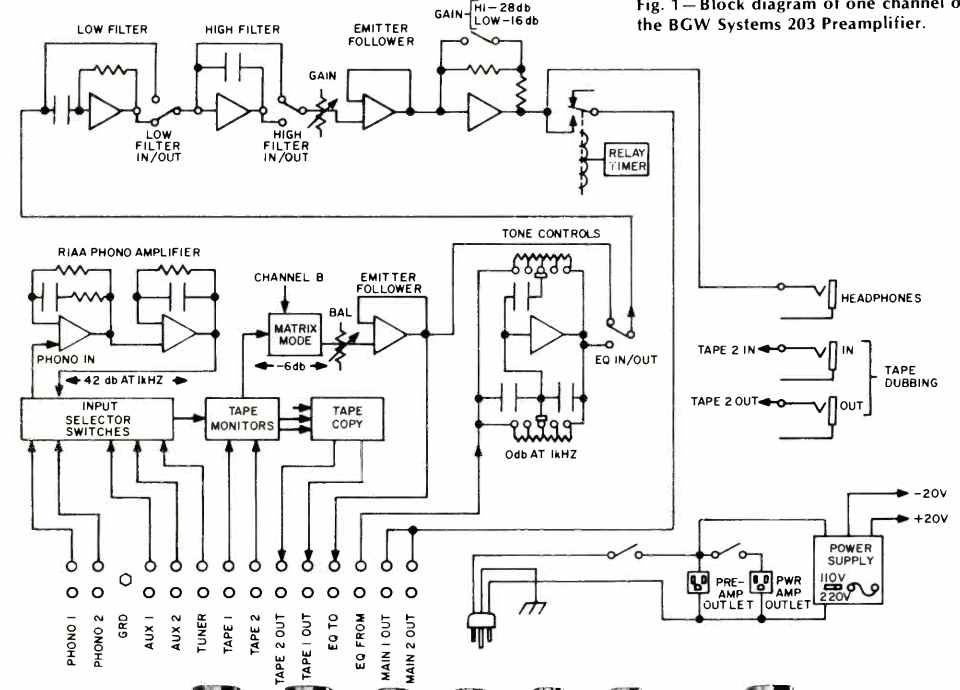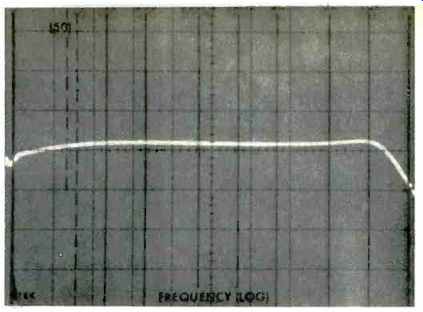


Typical of some of the newer pre-amplifier-control centers to appear recently, this rack-mountable unit from BGW Systems emphasizes precision control and flexibility that will appeal to audio enthusiasts who prefer "separates" for just those reasons and are less interested in "gimmick" controls than in uncolored sound. The all-black front panel of the 203, with its contrasting white control designations, lends an air of professional quality to the appearance of this unit. A large rotary switch at the upper left selects operational mode, including every possible combination of mono or stereo feed to left and right outputs, singly or jointly. Separate bass and treble rotary switch controls are provided for each channel, and these controls are not mechanically detented potentiometers, but rather actual step switches which pick off fixed resistor/voltage divider networks so as to provide 3 dB increments of boost or cut. A detented rotary control, calibrated in dB, serves as a balance control and a similarly calibrated 22-step, master gain control is located at the upper right of the panel.
Five interlocking pushbuttons at the lower left select program sources (which include two phono input pairs, two sets of auxiliary inputs, and tuner inputs). Two tape monitor pushbuttons come next, followed by two Tape Copy switches.
- - - -
MANUFACTURER'S SPECIFICATIONS
Rated Output: 4.0 volts.
Gain: Phono to Tape Out, 42 dB; High Level Inputs to Line Out, 22 dB or 10 dB (selectable).
Phono Overload: 100 mV.
Maximum Output Voltage: 8V into 600 ohms, line out.
THD: Less than 0.01 percent at rated output, Hz to 20 kHz; S/N Ratio: Phono, 82 dB below rated output (unweighted); High Level, 90 dB (re: low gain setting), 80 dB (re: high gain setting) referred to rated output.
Tone Control Range: ±18 dB @ 50 Hz and 15 kHz, in 3 dB steps.
High & Low Cut Filter Cutoff: 20 Hz and 12 kHz, 18 dB/octave.
Frequency Response:
Phono, RIAA ±0.25 dB; High Level, 20 Hz to 20 kHz, ±0.2 dB.
General Specifications
Power Requirements: 10 watts @ 120 V a.c. or 240 V a.c., 50-400 Hz.
Dimensions: 19 in. (48.3 cm) W x 5 3/8 in. (13.3 cm) H x 10 1/2 in. (27.3 cm) D.
Weight: 18 lbs. (8.16 kg).
Price: $649.00.
- - - -
Separating these functions in this way permits the user to copy programs from one deck to another while continuing to enjoy other program sources, so long as the monitor switches are not depressed. The next bank of pushbuttons includes an Equalizer-Defeat switch (special input and output jacks for connection of an external equalizer are provided on the rear panel and are interconnected by means of supplied jumpers which are removed if an external equalizer is added to the system), low- and high-cut filter buttons, and a gain determining button which alters high-level input gain from 10 dB to 22 dB. Tape-out/tape-in phone jacks come next, duplicating the Tape 2 jacks on the rear panel. Adjacent to them is a headphone jack which is effectively in parallel with the line out-signal (though signals are delivered to it even when the preamp-out or line-out circuitry is interrupted by a relay associated with the dual power switches). Headphones must be of a high impedance type to work with this control unit directly. A two-part power switch pushbutton arrangement permits separate powering of the preamp itself and any associated power amp connected to the appropriate rear panel a.c. receptacle.

Fig. 1-Block diagram of one channel of the BGW Systems 203 Preamplifier.

Fig. 2-Bass and treble control range.

Fig. 3-High-cut filter response.
Rear panel input, output, equalizer in/out jacks, and chassis ground terminal are all located on a horizontally oriented platform section which makes cable connection extremely convenient. Terminal nomenclature is screened on a vertical wall behind the various jacks, and this same vertical surface contains the convenience a.c. receptacles (one of which is switchable, as mentioned, by one section of the front-panel power switch and is therefore suitable for connection of the power amplifier line cord), a multiple-pin socket for connection of a head-amp accessory for use with moving-coil cartridges, and another socket that accepts a remote control accessory also available from BGW.
Internal Construction and Circuit Features
The power supply section of the 203 is contained in a fully shielded compartment, far removed from the low-level phono-equalizer circuitry, and includes a differential amplifier input stage, an emitter-follower, along with a dual transistor, compound voltage-amplifier stage, plus a second differential-amplifier pair and compound voltage-amplifier pair. In this manner, required low frequency RIAA boost and treble cut are provided by two separate and isolated circuit sections. A voltage-follower stage comes next, acting as an impedance converter to feed the three-pole active high- and 8 low-pass filters. The output of the master gain control feeds an operational amplifier which in turn feeds the variable gain voltage amplifier of the system. A block diagram of one channel of the 203 is shown in Fig. 1.
The major circuit board of the unit occupies nearly the entire "floor" of the chassis, while a vertically oriented board module supports the four tone control switches and mode selector switch which are directly soldered to it. A third, smaller board retains the master gain control and balance control as well as their associated fixed components. Interconnections between these p.c. board modules are made by means of slip-on terminals and posts which permit easy removal of any module for servicing, if required. All pushbutton switches along the lower edge of the panel have their contacts directly soldered to the main or "mother" board.
Laboratory Measurements
RIAA equalization in the sample we tested was highly accurate from 100 Hz to 15 kHz (within 0.2 dB of the prescribed playback curve), but there was a shelving effect which occurred at the extreme low end which caused the 30 Hz response to be "down" nearly 2.0 dB compared with the required boost at that frequency. Preamp-equalizer and high-level section gains were exactly as specified, so that a 1.0 volt output from the main line outputs was obtained with a phono input signal of only 0.75 mV when the preamp is operated in its high-gain mode; 3.0 mV for the low gain mode. Spot measurements of total harmonic distortion for rated output of 4.0 volts (much more than would normally be required by any power amplifier) yielded results of 0.01 percent at 20 Hz, 0.008 percent at 1 kHz, and 0.025 percent at 20 kHz with controls set for flat response. Phono overload capability fell a bit short of the 100 mV claimed, with an input of 88 mV at 1 kHz causing first-section distortion. IM distortion of the entire system (from phono input to output) measured a very low 0.006 percent. Overall frequency response through the high level inputs was flat from 20 Hz to 20 kHz within 0.5 dB. (Editor's Note: BGW informs us that some preproduction units, of which the unit tested was one, showed the shelving characteristic at the low end of the RIAA response. This was traced to a particular capacitor, which was changed in production, so that units actually on the market should track the RIAA curve within 0.2 dB.) The maximum range of the bass and treble tone controls is plotted in the 'scope photo of Fig. 2, and turnover frequency for both controls is set at around 550 Hz. The action of the steep-cutting low-pass filter is clearly seen in the photo of Fig.
3, but the low-cut filter action does not show up in this sweep because the cut-off point is set at 20 Hz, the lower limit of our sweep as displayed on the spectrum analyzer 'scope face.
Separate point-by-point metering of the output at frequencies below 20 Hz confirmed the 18-dB slope of this filter as well as its cut-off point as specified by the manufacturer.
Use and Listening Tests
The alternate choices of overall gain provided by the 203 are useful, particularly when trying to optimally match various program source levels with convenient master gain settings for specific power amplifiers with which the BGW preamp-control unit is likely to be used. Of course, the gain chosen then applies to all input program material and may, occasionally, have to be altered when switching from one program source to another. This feature is therefore not quite as flexible as would be the individual input level controls found on some other high-priced preamplifier control units.
The ultra-low noise characteristics of the phono equalizer section (82 dB below rated output, unweighted, as claimed) translate to extremely noise- and hum-free phono reproduction even at very loud listening levels and, even at the 88 mV overload limitation, the dynamic range of the phono section translates to around 100 dB-a good deal higher than one is likely to encounter with any present-day musical recording.
Control action of the 203 is smooth and precise; and we particularly appreciated the precision of those step-type tone controls and the fact that it was possible to control left and right channels separately (something that many preamp manufacturers have abandoned in recent years). The slight bass roll-off because of the shelved RIAA low-end equalization is easily corrected by simply cranking each bass control up by a single step position, and that still leaves enough bass boost available (more than enough, in fact) for any tonal compensation needed to take care of other program source or speaker deficiencies. All in all, the 203 is a well-executed, thoughtful design that, for its price, merits serious consideration and auditioning by audio perfectionists who crave this type of component.
(Audio magazine, Nov. 1977; Leonard Feldman)
Also see:
BGW Systems Model 500D Basic Power Amplifier (Dec. 1975)
= = = =